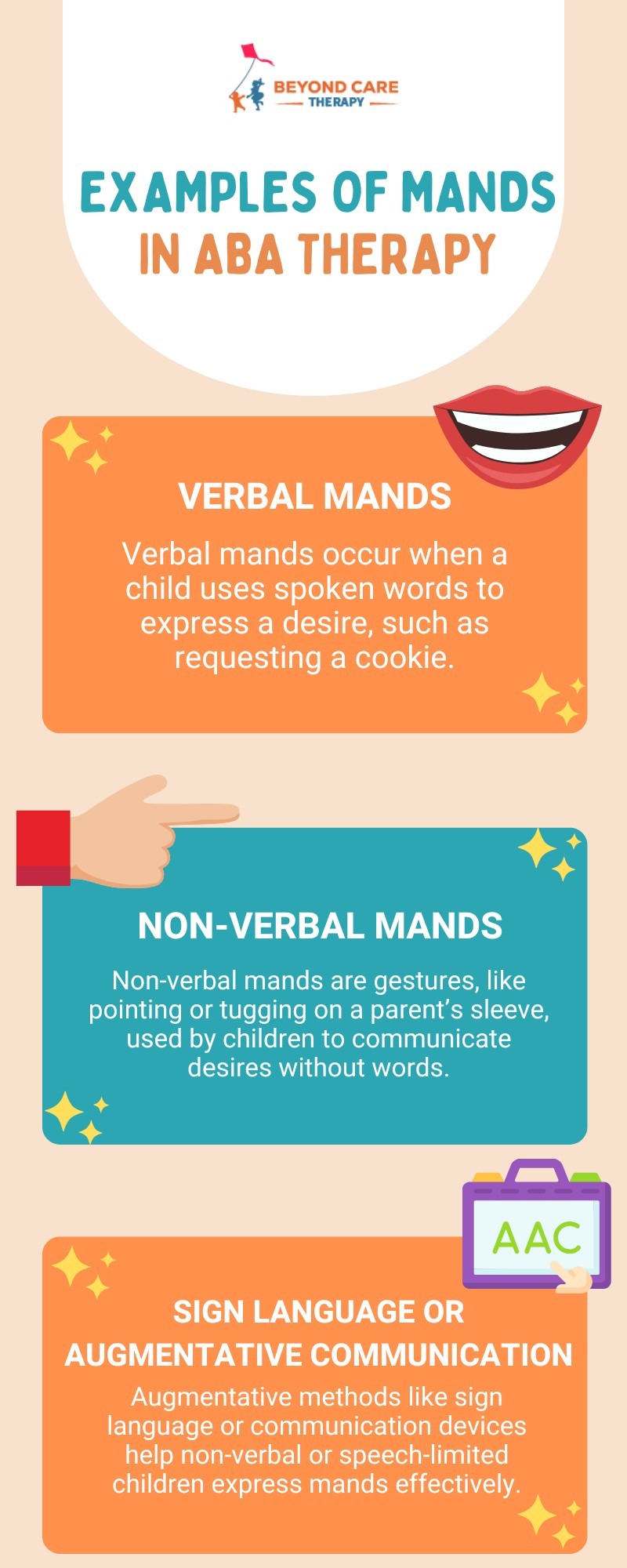Key Points:
- A mand in ABA refers to a request or demand for something, driven by a need or desire.
- Mands are one of the first communication skills taught in ABA therapy.
- They can be verbal or non-verbal and help children with autism express their needs in socially appropriate ways.
Understanding the concept of a mand in ABA therapy is essential for parents and caregivers, as it plays a significant role in helping children with autism communicate their needs effectively. By becoming familiar with how mands work, parents and caregivers can better support their child’s communication development both at home and in therapy sessions. Let’s dive into what a mand in ABA therapy really means and why it’s such a crucial part of learning!
What is a Mand ABA Definition?
In the context of ABA therapy, a mand is a type of request or demand that an individual makes for something they need or want. The term comes from B.F. Skinner’s analysis of verbal behavior, where mands are specifically defined as requests made in response to an internal motivation (like hunger, thirst, or the need for help).
To put it simply, when a child says “I want juice,” they are making a mand, asking for something they desire. It’s a behavior driven by a need or want, and it’s one of the first communication skills ABA therapists aim to teach. Unlike other types of verbal behaviors, such as tacts (comments about the environment), mands are focused on obtaining a specific outcome.

Why are Mands Important in ABA Therapy?
Mands are a foundational skill in ABA therapy because they serve as a form of functional communication. Instead of relying on behaviors like tantrums, meltdowns, or aggression to express needs, a child can learn to use words, gestures, or other communication methods to request what they want. Let’s look at the key reasons mands are so crucial in ABA therapy:
Improves Communication
Teaching children to make mands improves their ability to communicate effectively. When a child can request a toy, food, or help, they are reducing frustration and increasing their ability to connect with others.
Reduces Problem Behaviors
Mands can reduce inappropriate behaviors. For example, if a child learns to say, “I want a break” instead of throwing a tantrum, it allows for a more positive interaction.
Promotes Independence
By learning to make mands, children can gain more independence in various settings, whether at home, in school, or in social situations.
Supports Social Interaction
When a child can request items, they can participate in more meaningful social interactions. This skill is vital in building relationships with peers and adults.
Mands come in various forms, ranging from simple requests to more complex demands. These can be verbal or non-verbal, and the context often determines which method is best. Below are some examples of how mands can appear in ABA therapy:

How Are Mands Taught in ABA Therapy?
Mands are taught using a variety of techniques and strategies designed to reinforce communication. The most common methods for teaching mands in ABA therapy include:
Discrete Trial Training (DTT)
DTT is a method that breaks down tasks into smaller, clear steps. To teach mands, a therapist may present an object or situation that catches the child’s interest (such as a favorite toy) and encourage them to ask for it.
Natural Environment Teaching (NET)
NET involves teaching in natural settings, like at home or in the community. The therapist seizes opportunities where the child is motivated to request something, such as asking for a snack when they’re hungry.
Prompting and Fading
In the initial stages of teaching a mand, therapists often provide prompts to guide the child in making a request. These can be verbal cues like “Say ‘juice’” or physical guidance like helping the child point to the item. Gradually, the therapist reduces these prompts until the child can independently make the request.
Reinforcement
When a child successfully makes a mand, the therapist reinforces the behavior immediately. This might involve giving the child the requested item (such as a toy or food) or providing positive feedback, like praise, to encourage them to continue using mands.
Why Are Mands the First Skill Taught in ABA?
Mands are often taught before other skills because they are the most practical and essential form of communication for children with autism. When a child learns to request something, it immediately improves their quality of life by reducing frustration and increasing opportunities for interaction. Teaching mands helps lay the foundation for more advanced communication skills and further behavioral development.
Start Your ABA Journey with Beyond Care Therapy
Understanding the mand ABA definition is crucial to your child’s communication development in ABA therapy. It’s a vital tool that helps children learn to express their needs in a positive, effective way. As a parent, teaching your child to use mands can significantly reduce frustration and improve their ability to connect with others.
At Beyond Care Therapy, we specialize in helping children on the autism spectrum build essential communication and behavioral skills. Our team of trained professionals is dedicated to providing personalized ABA therapy designed to meet the unique needs of your child. Whether you’re looking to teach mands or improve other areas of communication, we’re here to support you every step of the way.
We offer ABA therapy in Arizona, Utah, Texas, Massachusetts and surrounding areas. Get in touch today to learn more about how our ABA therapy services can help your child thrive!

